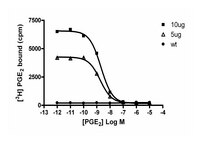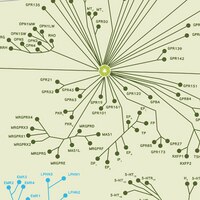HTS092M Sigma-AldrichChemiSCREEN™ EP3 Prostanoid Receptor Membrane Preparation
Human EP3 GPCR membrane preparation for Radioligand binding Assays & GTPgammaS binding.
More>> Human EP3 GPCR membrane preparation for Radioligand binding Assays & GTPgammaS binding. Less<<Produits recommandés
Aperçu
Tableau de caractéristiques principal
| Species | Host Cells | Protein Target |
|---|---|---|
| Human | Chem-1 | EP3 |
| Product Information | |
|---|---|
| Format | Membranes |
| Presentation | One package contains enough membranes for at least 200 assays (units), where a unit is the amount of membrane that will yield greater than 10-fold signal:background with 3H-labeled PGE2 at 1.5 nM Liquid in packaging buffer: 50 mM Tris pH 7.4, 10% glycerol and 1% BSA no preservatives. Packaging method: Membranes protein were adjusted to 0.5 mg/ml in 1 ml packaging buffer, rapidly frozen, and stored at -80°C. |
| Quality Level | MQ100 |
| Product Usage Statements |
|---|
| 10 µg/well | 5 µg/well | |
|---|---|---|
| Signal:Background | 38 | 21 |
| Specific Binding (cpm) | 6,386 | 4,053 |
Specifications:
1 unit = 10 μg
Bmax: 15.0 pmol/mg
Kd: 1.56 nM
Usage Statement
- Unless otherwise stated in our catalog or other company documentation accompanying the product(s), our products are intended for research use only and are not to be used for any other purpose, which includes but is not limited to, unauthorized commercial uses, in vitro diagnostic uses, ex vivo or in vivo therapeutic uses or any type of consumption or application to humans or animals.
| Storage and Shipping Information | |
|---|---|
| Storage Conditions | Maintain frozen at -70°C for up to 2 years. Do not freeze and thaw. |
| Packaging Information | |
|---|---|
| Material Size | 200 assays |
| Global Trade Item Number | |
|---|---|
| Référence | GTIN |
| HTS092M | 04053252363351 |










